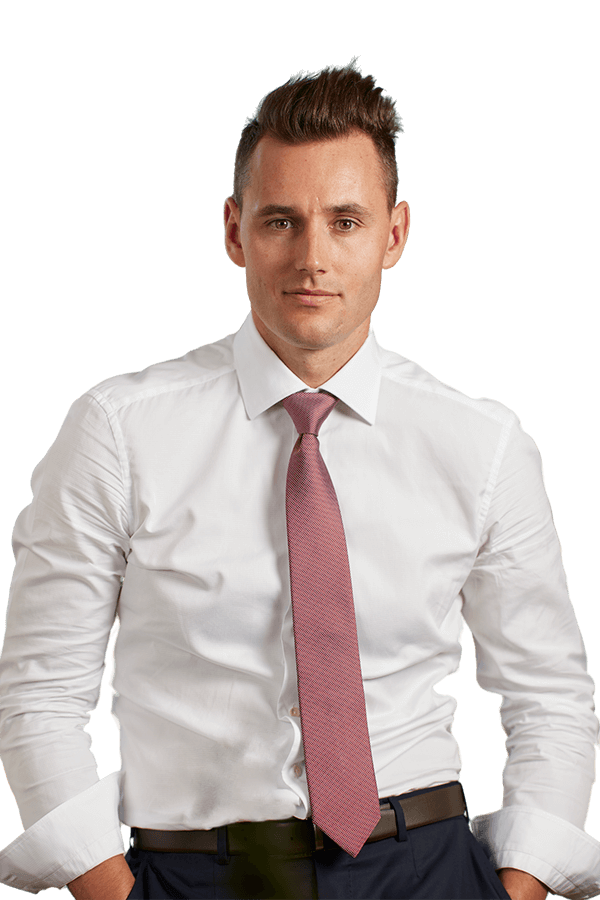Cervical laminectomy
to treat cervical myelopathy
Cervical laminectomy key points
- Cervical laminectomy is one of two procedures to treat cervical myelopathy.
- As this is a very serious condition, the focus of surgery is purely on preventing you from getting worse and avoiding you ending up in a wheelchair.
- Surgery is the only recommended way to treat cervical myelopathy. When I see you it will become clear whether cervical laminectomy is the best option, or the alternative procedure which is called Anterior Cervical Discectomy and Fusion (ACDF).
Cervical laminectomy | Spine surgery Brisbane
The surgeon said cervical laminectomy. What exactly is that?
The spine is like a skyscraper with 31 levels in total. The elevator shaft is called the spinal canal, extending from your head all the way to your tailbone (or in our analogy, from the penthouse to the basement). The spinal cord lies in this canal.
This canal can get narrowed by arthritic tissue. In the neck this narrowing squashes and injures the spinal cord, causing a condition called cervical myelopathy.
Cervical laminectomy is one of two ways to treat this condition. The other option is ACDF. Cervical laminectomy takes away the back of the canal to create more space for the injured spinal cord. In contrast, ACDF takes away the front of the canal to create more space for the cord.
You will have a general anaesthetic (i.e you will be ‘knocked out’ for the whole surgery).
The incision is made down the middle of the back of the neck. The muscles are retracted either side to reveal the bones at the back of the spine. These bones are usually about 5-7cm deep under the skin (the spinal cord sits another 1cm under the bone). The bones making up the back of the spine are then removed, creating a new space for the spinal cord. The bone is not replaced. This is not a concern for the future, however. The spinal cord sits on average 6-8cm under the skin, so there is little chance of someone causing problems by touching the back of your neck in the future.
Cervical laminectomy risks
Is it safe?
Modern technology has made this a safe and effective operation in the 21st century.
However, the most important thing to remember is surgery doesn’t make you better. It only stops you from getting worse.
Surgery cannot repair the injured spinal cord, only relieve the pressure so it can attempt to repair itself. Having said that, many patients do report an improvement. Without surgery, the reality is the patient will continue to get worse rapidly. It is a very serious condition.

Spinal surgeon Brisbane
If you have been diagnosed with this and want my review, please contact my team to book an urgent appointment. I then will also explain the risks associated with surgery.
- Bleeding. This rarely causes a problem.
- Nerve damage. Fortunately it is very rare nowadays to get nerve damage from this type of surgery.
- Infection. This is rare in modern surgical practice:
- Antibiotics. When these were invented in the 1940’s, surgery was utterly transformed.
- Proper skin care during and after surgery. Healthy skin is a vital barrier to infection: ‘If you look after the skin, the skin will look after you!’
- Shorter surgery. While there is no cut off point, it is well recognised that the more efficient the surgery, and the less time taken, the lower the risk.
- General risk of the anaesthetic like clots in the legs, clots in the lungs, urinary tract infections, skin injuries from being on a bed for a long time, and heart or kidney problems. Modern anaesthetic medicine makes many of these risks very low.
Cervical laminectomy success rate
Will I be back to normal again?
Unfortunately, a lot of the symptoms are caused by permanent injury to the spinal cord, meaning it is unlikely you will return completely to normal.
This is not the focus, however. The focus is purely on preventing you from getting worse. This is critical. A full blown condition can mean life in a wheelchair. Surgery can potentially prevent this.

Spinal surgeon Brisbane
The condition is common enough and serious enough that spine surgeons are constantly on the lookout for it.
The surgery itself has little long term side effects. Neck stiffness is commonly reported but rarely problematic.
Cervical laminectomy alternatives
Are there any other good options?
Surgery is the only recommended option to treat cervical myelopathy. When I see you it will become clear whether cervical laminectomy or ACDF is the best option.
This is not recommended. Without surgery the patient will suffer preventable further loss of neurological function. At its worst, the patient could end up in a wheelchair. Prompt surgery is strongly recommended.
If you have been diagnosed with this and want to discuss this further, please contact my team to book an urgent appointment.
The muscles do get sore after this type of surgery but modern painkillers are very effective at keeping you comfortable during the recovery process.
The scar for cervical laminectomy ends in a good cosmetic result.
There is no suture to remove as they are all dissolvable.
Generally between 24 and 72 hours.
Cervical laminectomy recovery
What can and can't I do afterwards?
To get the best result you need to commit to a full recovery period. But this does not mean you will be just resting during the recovery.
I always say: Recovery is like compound interest; if you do the time, you’ll get the best result. If you shortchange yourself and bail out early you will miss out on significant benefits long term.

Spinal surgeon Brisbane
I will actually encourage you to be as active as possible. It is very important to get your confidence back as soon as possible, and you will be surprised how much you are allowed to do straight after surgery.
I recommend a minimum of 2 weeks off work to get your confidence back and feel comfortable.
Physiotherapy has a very important role postoperatively. It helps reduce the muscle soreness and stiffness from the surgery. It also helps treat the problems in your arms and legs caused by the spinal cord injury from the original problem.
Spinal surgeon Brisbane
What else do I need to know?
If you have been diagnosed with this and want to discuss this further, please contact my team to book an urgent appointment.
Ready to make an appointment?
Ramsay Specialist Centre
Suite 325
Newdegate St
Greenslopes QLD 4120

